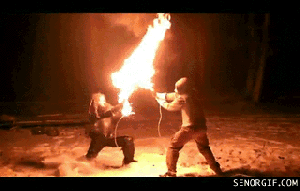Post by Benzo Washington on Aug 3, 2015 4:17:12 GMT
Of my few hobbies, one of them involves creating space-themed spray paintings, as seen above. Normally, I would never call myself an artist, but my sister once showed me this method, (which I'm sure she just got from YouTube,) which is actually a whole hell of a lot easier than it appears. I'll go through the process, for anyone wanting to give it a try.
And for the love of God, do this outside, where you aren't going to end up pissing someone off.
Items Needed:
Canvas - Not really canvas, but whatever you paint on. I find poster board to be a cheap and sturdy choice.
Spray paint - Each planet uses 2-3 colors. See what goes good together! And black paint is typically best bought in bulk due to the background using a lot.
Newspaper
Open-ended circular containers - This will be your planet's sizes. They WILL get paint on them. Pringles cans, buckets, ect.
Plastic Spoon* - Not needed, but I find it useful, and cleaner, for part of the process.
Plastic Gloves* - Obvious way to not have to deal with painted hands.
Directions:
1) After finding a good area to paint, set down what you're painting on and try various locations upon it to place your open-ended containers until you determine where you want to place your planets, and what sizes.
2) Each planet uses a variation of colors to create the surface design. I usually find that 2 or 3 tend to work best, in my opinion. After finding your planet locations, move the containers and spray the LIGHTER of your chosen colors. That is, the weaker of the colors; An example being pink is a lighter color than purple.
Be sure to cover the entire area where the container was, and do not fear of spraying too much.
3) Use your second lightest chosen color and lightly spray over the previous layer, being more conservative with it as it should be a more dominate color than before. Repeat this step for each color of the planet, continuing to increase darkness and decrease thickness of each layer.
4) Tearing your newspaper into small sections and crumple a couple pieces into fist-sized balls. Uncrumple them slightly to create a wave-like pattern, then dabbing the newspaper over the painted area lightly.
If you take off too much paint, repeat steps 2 and 3 until you create a texture you are happy with.
5) For each planet, repeat steps 2 through 4. Give your painting time to dry completely before continuing further; failure to do so risks tearing the canvas and stripping the paint of your planets.
6) After your patterns are dried, place the open-ended containers you had used before over their previous locations. What is inside the container's perimeter will be your planet, so adjust within the painted area as you like.
7) With your containers in place, COMPLETELY cover the rest of your canvas in black paint. As before, give your painting time to dry before proceeding onto the next step.
8) Select the color of paint you wish to use for stars. I find that either white or yellow both work well for this. Using a plastic spoon, spray into the lip and flick the paint across your painting. Continue refilling and flicking until you have as many stars as you like.
If you do not have a spoon, your index finger can be used to flick the paint all the same. However, it will take much more time this way, if you wish to have a lot of stars.
*Anything past here is completely optional but adds more detail to your painting. Complete any or all of these in the order they appear.)
Shooting Stars: To create a shooting star, such as that in the upper-right of the piece above, place the top side of the spray nozzle of your star-colored spray paint gently against the canvas. Point the nozzle in whichever direction you want the tail to go and VERY LIGHTLY tap the bottom of the spray can.
Be warned, too hard of a tap will create a solid cone, rather than a shooting star's tail. This is very risky to do, so try a couple practice taps on newspaper first.
Space Dust: You might be able to notice a slight hue of complimenting color around the planets; I refer to this as 'Space Dust'. Leaving your containers on your planets, hold your selected color a fair distance, about 18 to 24 inches from the canvas, and lightly spray a mist over your canvas. Try to avoid spraying from directly above, but rather, from a side angle.
Planet Shadow: Sometimes, a planet looks better with a slight shadow, giving it more of a 3D appearance to it. With your black paint, move whichever planet's container slightly to one side to then expose the color-scheme beneath it. VERY lightly spray around the edge of the exposed area with a mist of black, having the outer-most area thicker than inside.
And with that, you should be done! Admire your painting and, if you'd like, show us a picture here so we can see what different color combinations have been used, eh?







